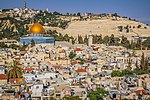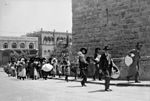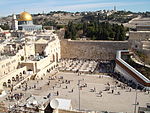The Western Wall (Hebrew: הַכּוֹתֶל הַמַּעֲרָבִי, romanized: HaKotel HaMa'aravi, lit. 'the western wall', often shortened to the Kotel or Kosel), known in the West as the Wailing Wall, and in Islam as the Buraq Wall (Arabic: حَائِط ٱلْبُرَاق, Ḥā'iṭ al-Burāq Arabic pronunciation: ['ħaːʔɪtˤ albʊ'raːq]), is a portion of ancient limestone wall in the Old City of Jerusalem that forms part of the larger retaining wall of the hill known to Jews and Christians as the Temple Mount. Just over half the wall's total height, including its 17 courses located below street level, dates from the end of the Second Temple period, and is believed to have been begun by Herod the Great. The very large stone blocks of the lower courses are Herodian, the courses of medium-sized stones above them were added during the Umayyad period, while the small stones of the uppermost courses are of more recent date, especially from the Ottoman period.
The Western Wall plays an important role in Judaism due to its proximity to the Temple Mount. Because of the Temple Mount entry restrictions, the Wall is the holiest place where Jews are permitted to pray outside the previous Temple Mount platform, as the presumed site of the Holy of Holies, the most sacred site in the Jewish faith, lies just behind it. The original, natural, and irregular-shaped Temple Mount was gradually extended to allow for an ever-larger Temple compound to be built at its top. The earliest source mentioning this specific site as a place of Jewish worship is from the 17th century. It also has a place in Muslim tradition, in which it is believed to be the site where the Islamic Prophet Muhammad tied his winged steed, al-Buraq, on his Isra and Mi'raj to Jerusalem before ascending to paradise, and constitutes the western border of al-Haram al-Sharif ("the Noble Sanctuary"), or the Al-Aqsa compound.
The term Western Wall and its variations are mostly used in a narrow sense for the section of the wall used for Jewish prayer and called the "Wailing Wall", referring to the practice of Jews weeping at the site. During the period of Christian Roman rule over Jerusalem (ca. 324–638), Jews were completely barred from Jerusalem except on Tisha B'Av, the day of national mourning for the Temples. The term "Wailing Wall" has historically been used mainly by Christians, with religious Jews generally considering it derogatory. In a broader sense, "Western Wall" can refer to the entire 488-metre-long (1,601 ft) retaining wall on the western side of the Temple Mount. The classic portion now faces a large plaza in the Jewish Quarter, near the southwestern corner of the Temple Mount, while the rest of the wall is concealed behind structures in the Muslim Quarter, with the small exception of an 8-metre (26 ft) section, the so-called "Little Western Wall" or " Small Wailing Wall". This segment of the western retaining wall derives particular importance from never been fully obscured by medieval buildings, and displaying much of the original Herodian stonework. In religious terms, the "Little Western Wall" is presumed to be even closer to the Holy of Holies and thus to the "presence of God" (Shechina), and the underground Warren's Gate, which has been out of reach for Jews from the 12th century till its partial excavation in the 20th century.
While the wall was considered an integral part of the Haram esh-Sharif and waqf property of the Moroccan Quarter under Muslim rule, a right of Jewish prayer and pilgrimage has long existed as part of the Status Quo. This position was confirmed in a 1930 international commission during the British Mandate period. With the rise of the Zionist movement in the early 20th century, the wall became a source of friction between the Jewish and Muslim communities, the latter being worried that the wall could be used to further Jewish claims to the Temple Mount and thus Jerusalem. During this period outbreaks of violence at the foot of the wall became commonplace, with a particularly deadly riot in 1929 in which 133 Jews and 116 Arabs were killed, with many more people injured. After the 1948 Arab–Israeli War the eastern portion of Jerusalem was occupied by Jordan. Under Jordanian control Jews were completely expelled from the Old City including the Jewish Quarter, and Jews were barred from entering the Old City for 19 years, effectively banning Jewish prayer at the site of the Western Wall. This period ended on June 10, 1967, when Israel gained control of the site following the Six-Day War. Three days after establishing control over the Western Wall site, the Moroccan Quarter was bulldozed by Israeli authorities to create space for what is now the Western Wall plaza.











